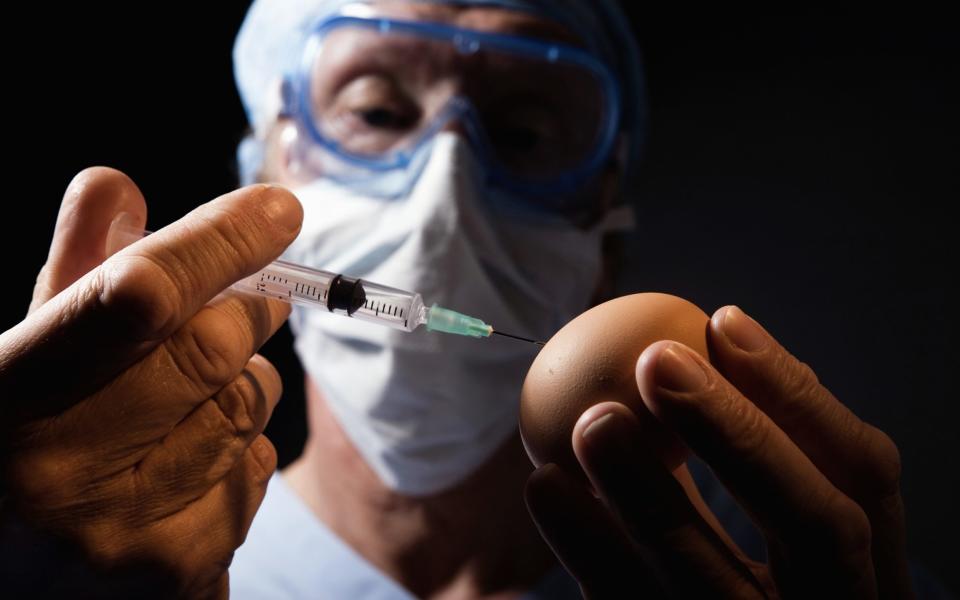Using moths as “living bioreactors” could allow scientists to develop pandemic vaccines within 100 days of the emergence of a new virus, experts have said.
A Spanish biotech company is using insects known for devouring wardrobe classics in a new vaccine production technique described as cheaper, simpler and faster than existing approaches.
Moths have been used in a similar way to chicken eggs to make flu vaccines for about 80 years. However, instead of replicating the vaccine inside fertilized eggs, scientists grow the vaccine using moth chrysalis.
Not only do moths produce more vaccine antigens faster, they can also be used to grow a much wider variety of eggs than chicken eggs. This can make installation easier on lower resource settings.
“It’s cheap, simple and effective,” Dr José Escribano, founder of biotech Algenex, told the Telegraph.


This week the Epidemic Preparedness Coalition (Cepi) supported the approach with a £2.5 million grant.
This is part of the organization’s “100 Day Mission,” a global project to ensure we can respond to the next pandemic by producing safe, effective vaccines within 100 days.
Moth technology is already used in some animal vaccines, including the vaccine against fatal rabbit hemorrhagic disease.
The approach involves modifying baculovirus, a pathogen that infects insects but is harmless to humans and animals, with genetic instructions to produce the antigen of a specific virus.
This modified virus is then inserted into the moth chrysalis by robots that can inject 6,000 moth cocoons per hour.
The cells inside the insect respond to the virus, the virus multiplies rapidly and produces antigen much more quickly than in bioreactors.
“After three to five days you reach the maximum peak of protein [the antigen]said Dr. Escribano.
He added that each pupa should produce five to 10 doses of vaccine, while a single chicken egg corresponds to only one flu vaccine.


This approach is being used to create protein-based vaccines, not the mRNA vaccines developed by companies such as BioNTech and Moderna to protect against Covid-19.
Describing chrysalis as “living bioreactors,” Cepi said this new approach could save critical time and allow more vaccines to be produced and distributed quickly in the event of another outbreak.
“With new and emerging infectious diseases posing a constant threat, the need for rapid access to vaccines is critical to protecting vulnerable populations around the world,” said Ingrid Kromann, the organization’s acting executive director of manufacturing and supply chain.
The approach is based on precedents. Baculoviruses have long been used in vaccine development because they are harmless to humans; The Novavax Covid vaccine (approved much later than BioNTech’s Moderna due to scale-up issues in the bioreactor) contained a baculovirus modified to contain the Sars-Cov-2 spike protein.
Prof Danny Altmann, professor of immunology at Imperial College London, said creating a “living bioreactor” was a “real and highly respected direction”.
“[It’s] It’s not as exotic as the ‘moth’ thing makes it sound; “Any team looking for robust ways to faithfully produce large batches of protein for a vaccine strategy can compare tissue culture production in human, yeast, bacterial and insect cells,” he said.
Prof Edward Parker, co-director of the Vaccine Center and the London School of Hygiene and Tropical Medicine, added: “There are several adaptations of the chrysalis-based system that aim to simplify and improve existing methods, so it will be interesting to see where it stands.” This leads.


Similar approaches are already taking place elsewhere. Some teams, including scientists at Chulalongkorn University in Bangkok, used plants instead of insects to clone the viral components needed for the vaccine.
There are hopes of using this type of technology for other conditions; Dr Escribano said his team was also using the platform to make a resilience molecule for stroke patients, while the group in Thailand was trying to use plants to produce snake antivenom.
But others are less convinced about whether this technology can actually speed up vaccine development. Prof Ian Jones, professor of virology at the University of Reading, said the approach was “formally not new” as previous companies had gone out of business despite offering similar technologies.
“Other emerging technologies, particularly mRNA vaccines, do not require biological production at all, thus eliminating the need for rapid protein production,” he added. “All in all, while it’s another technology with a niche of its own, it doesn’t appear to be a game-changer in any way.”
Cepi’s latest grant aims to provide proof of concept. Algenex will conduct a preclinical study for a flu vaccine to demonstrate the technology’s potential for rapid deployment in a pandemic situation.
“[This funding] It allows us to fully unlock the potential of our platform and enable the development of the next generation of globally accessible human vaccines,” said Escribano.
Protect yourself and your family by learning more about Global Health Security